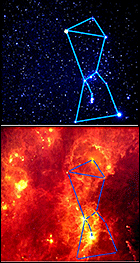infrared
Alert Notice 482: Monitoring requested for dust production study in developing planetary systems
April 4, 2013: Huan Meng and Dr. George Rieke (University of Arizona) have requested AAVSO assistance in monitoring three bright stars with developing planetary systems. The stars have been observed with NASA's Spitzer Space Telescope to have varying levels of dust in the circumstellar disk. These varying levels are thought to be produced through collisions among the asteroid-size debris in the disk.
Alert Notice 482: Monitoring requested for dust production study in developing planetary systems
April 3, 2013: Huan Meng and Dr. George Rieke (University of Arizona) have requested AAVSO assistance in monitoring three bright stars with developing planetary systems. The stars have been observed with NASA's Spitzer Space Telescope to have varying levels of dust in the circumstellar disk. These varying levels are thought to be produced through collisions among the asteroid-size debris in the disk.
Alert Notice 478: Transformed photometry of young stars in Cha requested
January 16, 2013: Dr. Péter Ábrahám (Konkoly Observatory, Budapest, Hungary) has requested the assistance of AAVSO observers in monitoring eight young stars in Chamaeleon in support of photometry he and his colleagues will be obtaining with the VLT/ISAAC (infrared) and Herschel Space Observatory (far-infrared) during January-February 2013.
SSP-4 Targets and Comparison Stars
SSP-4 Targets and Comparison Stars
Table 1 - SSP-4 Target List
|
Star |
SAO |
Spectral Class |
Var Type |
Period (d) |
QX Pup
Update (July 7, 2015): I-band coverage of QX Pup by AAVSO observers since 2010 clearly shows that the period given in the 4th Edition of the GCVS of 648: days is incorrect. A phase plot by Sebastián Otero of these data shows that the period of QX Pup in Ic is 551 days.
The Field of QX Pup
This is a multiple set of projects, so pick and choose what aspects of them interest you.
Infrared Photoelectric Photometry Program
What is Infrared Photometry?
Infrared astronomy is an exciting new area of observation and study for the amateur astronomer, and there is huge potential for amateur astronomers to break new ground and contribute important observations to this exciting field of research.
amateur astronomers to break new ground and contribute important observations to this exciting field of research.

